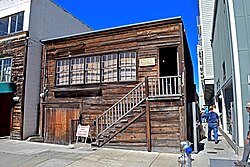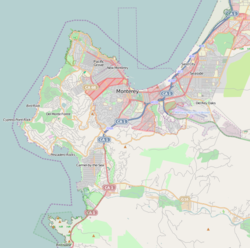
John Ernst Steinbeck was an American writer. He won the 1962 Nobel Prize in Literature "for his realistic and imaginative writings, combining as they do sympathetic humor and keen social perception". He has been called "a giant of American letters."
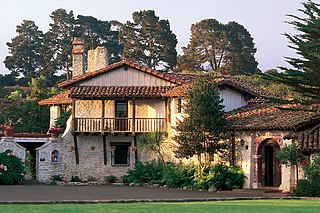
Monterey is a city in Monterey County on the southern edge of Monterey Bay on the U.S. state of California's Central Coast. Founded on June 3, 1770, it functioned as the capital of Alta California under both Spain (1804–1821) and Mexico (1822–1846). During this period, Monterey hosted California's first theater, public building, public library, publicly funded school, printing press, and newspaper. It was originally the only port of entry for all taxable goods in California. In 1846, during the Mexican–American War of 1846–1848, the United States Flag was raised over the Customs House. After Mexico ceded California to the U.S. at the end of the war, Monterey hosted California's first constitutional convention in 1849.

Cannery Row is a waterfront street in the New Monterey section of Monterey, California, known for formerly being home to a number of now-defunct sardine canneries. The last closed in 1973. The street name, formerly a nickname for Ocean View Avenue, became official in January 1958 to honor John Steinbeck and his novel Cannery Row. In the novel's opening sentence, Steinbeck described the street as "a poem, a stink, a grating noise, a quality of light, a tone, a habit, a nostalgia, a dream." The street borders the adjacent city of Pacific Grove.
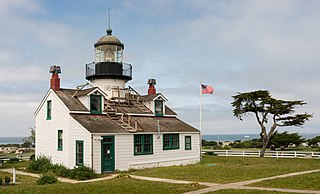
Pacific Grove is a coastal city in Monterey County, California, in the United States. The population at the 2020 census was 15,090. Pacific Grove is located between Point Pinos and Monterey.

Edward Flanders Robb Ricketts was an American marine biologist, ecologist, and philosopher. Renowned as the inspiration for the character Doc in John Steinbeck's 1945 novel Cannery Row, Rickett's professional reputation is rooted in Between Pacific Tides (1939), a pioneering study of intertidal ecology. A friend and mentor of Steinbeck, they collaborated on and co-authored the book, Sea of Cortez (1941).
Bruce Wallace Ariss, Jr. was an American painter, muralist, writer, illustrator, editor as well as theater and set designer, amateur playwright and actor, and overall icon on the Monterey Peninsula, California.

Sweet Thursday is a 1954 novel by John Steinbeck. It is a sequel to Cannery Row and set in the years after the end of World War II.

Cannery Row is a novel by American author John Steinbeck, published in 1945. It is set during the Great Depression in Monterey, California, on a street lined with sardine canneries that is known as Cannery Row. The story revolves around the people living there: Lee Chong, the local grocer; Doc, a marine biologist; and Mack, the leader of a group of derelict people.

Fisherman's Wharf is a historic wharf in Monterey, California, United States. Used as an active wholesale fish market into the 1960s, the wharf eventually became a tourist attraction as commercial fishing tapered off in the area.
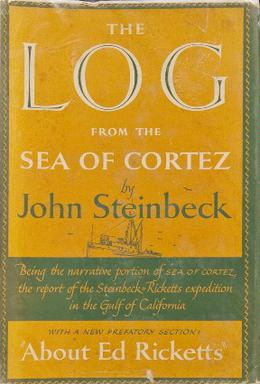
The Log from the Sea of Cortez is an English-language book written by American author John Steinbeck and published in 1951. It details a six-week marine specimen-collecting boat expedition he made in 1940 at various sites in the Gulf of California, with his friend, the marine biologist Ed Ricketts. It is regarded as one of Steinbeck's most important works of non-fiction chiefly because of the involvement of Ricketts, who shaped Steinbeck's thinking and provided the prototype for many of the pivotal characters in his fiction, and the insights it gives into the philosophies of the two men.
Joel Walker Hedgpeth was a marine biologist, environmentalist and author. He was an expert on the marine arthropods known as sea spiders (Pycnogonida), and on the seashore plant and animal life of southern and northern California; he co-authored Between Pacific Tides, the definitive guide to California intertidal organisms. He was a spokesperson for care for the floral and faunal diversity of the California coastline.
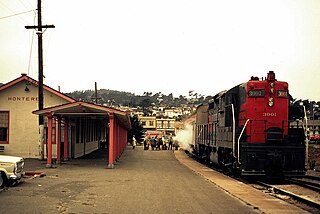
The Del Monte was a passenger train operated by the Southern Pacific Railroad between San Francisco and Monterey, California. It ran from 1889 to 1971.

Edward F. Ricketts State Marine Conservation Area is one of four small marine protected areas located near the cities of Monterey and Pacific Grove, at the southern end of Monterey Bay on California’s central coast. The four areas together encompass 2.96 square miles (7.7 km2). Within SMCAs fishing and take of all living marine resources is prohibited except the recreational take of finfish by hook-and-line and the commercial take of giant and bull kelp under certain conditions.
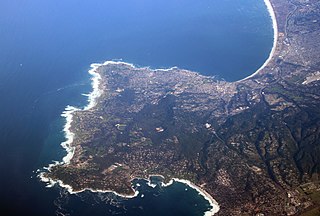
The Monterey Peninsula anchors the northern portion on the Central Coast of California and comprises the cities of Monterey, Carmel, and Pacific Grove, and the resort and community of Pebble Beach.

The Western Flyer is a fishing boat, most known for its use by John Steinbeck and Ed Ricketts in their 1940 expedition to the Gulf of California, the notes from which culminated in their 1941 book Sea of Cortez, later reworked by Steinbeck into The Log from the Sea of Cortez (1951). According to Kevin Bailey, "the most famous fishing vessel ever to have sailed", the 77-foot (23 m) Western Flyer was restored in Port Townsend, Washington. The Western Flyer Foundation was formed with the goal of educating youth about the intersection of science and literature.

The Hovden Cannery in Cannery Row, Monterey, California, was among the oldest, largest canneries of the Pacific Sardine Fishery. In the first half of the 20th century, it marked one of the most lucrative national fisheries. It was a source for literary inspiration in the works of John Steinbeck.
Walter Kenrick Fisher was an American zoologist, evolutionary biologist, illustrator, and painter. He taught in Stanford University before eventually becoming Emeritus Professor in Zoology until his retirement in 1943. Fisher was the son of ornithologist Albert Kenrick Fisher.
Knut Hovden was a Norwegian canner, innovator, and businessman.
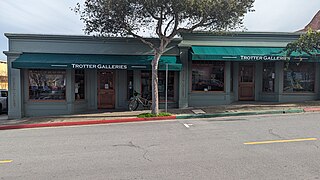
Trotter Museum-Gallery is a museum and art gallery located in Pacific Grove, California, dedicated to preserving and showcasing the artistic and cultural heritage of the Monterey Peninsula region art.
